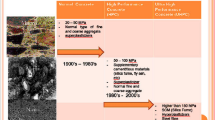Abstract
In High Performance Concrete structures, both the increased strength as well as the improved microstructure can be utilized. Both effects are achieved using an optimized concrete technology, namely an extremely low w/c-ratio and the addition of silica fume. In the case of High Performance Concrete, reinforcement can be minimized and/or the dimensions of the structural members can be reduced. This type of concrete is mainly used for columns, walls, etc. within high-rise buildings, as an alternative to steel structures. However, in comparison with normal reinforced concrete structures, some additional measures are necessary to obtain an adequate fire resistance. Some interesting applications for high-rise buildings in Germany are presented.
The dense microstructure of HPC is mainly used in case where, because of chemical attack or abrasion, additional protective measures are necessary in normal concrete structures. These measures can be avoided by using such a concrete.
Résumé
Dans les ouvrages en béton de haute performance, on utilise à la fois l'amélioration de la résistance et l'amélioration de la microstructure. Ces deux effets sont obtenus par l'utilisation d'une technologie optimisée, c'est-à-dire un rapport eau/ciment extrêmement bas et l'ajout de fumée de silice. Dans le cas du béton de haute performance, l'on peut minimiser le renforcement et/ou les dimensions des membres structurels. Ce béton est utilisé principalement pour des colonnes, des murs ... dans des bâtiments à étages multiples en substitution à des ouvrages en acier. Cependant, en comparaison avec des ouvrages armés ordinaires, il est nécessaire de prendre quelques mesures complémentaires afin d'obtenir une résistance suffisante au feu. Quelques applications intéressantes à des bâtiments à étages multiples en Allemagne sont présentées.
La microstructure dense du BHP est utilisée principalement dans des cas où en raison d'attaque chimique ou d'abrasion, des mesures complémentaires de protection sont nécessaires dans des ouvrages en béton ordinaire. Ces mesures peuvent être évitées par l'utilisation d'un tel béton.
Similar content being viewed by others
References
Mayer, L., ‘Hochfester Beton im Hochhausbau’,Beton- und Stahlbetonbau 86 (11) (1991) 261–265.
Mayer, L., ‘Neue Entwicklungen beim Einsatz von Hochleistungsbeton’, Presentation at the Deutschen Betontag 1995 in Hamburg, Proceedings, 342–359.
Kern, E. and Scherer, H., ‘Hochfester Beton-Betontechnologie und Qualitätssicherung beim Bau des Hochhauses Mainzer Landstraße 16-28 in Frankfurt/Main’,Beton- und Stahlbetonbau 86 (12) (1991), 303–309.
Bentur, A., ‘Microstructure of High Strength Concrete’, Darmstädter Massivbau-Seminar “Hochfester Beton”, 1991. Vol. 6.
Held, M and König, G., ‘Hochfester Beton bis B 125-Ein geeigneter Baustoff für hochbelastete Druckglieder’,Beton- und Stahlbetonbau 87 (2–3) (1992).
Breitenbücher, R., ‘High Strength Concrete C 105 with Increased Fire-Resistance due to Polypropylen-Fibers’, 4th Symposium on “Ultilization on High Strength/High Performance Concrete”, Paris 1996, Proceedings, 571–577.
Author information
Authors and Affiliations
Additional information
Editorial note Dr.-Ing. R. Breitenbücher is a RILEM Senior Member and a member of TC 119-TCE on Avoidance of Thermal Cracking in Concrete at Early Ages.
Rights and permissions
About this article
Cite this article
Breitenbücher Developments and applications of high-performance concrete. Mat. Struct. 31, 209–215 (1998). https://doi.org/10.1007/BF02480402
Received:
Accepted:
Issue Date:
DOI: https://doi.org/10.1007/BF02480402




